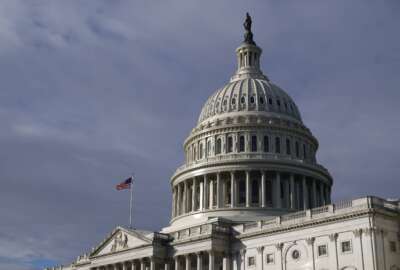Forest Service lifts hiring pause, but plans to only fill ‘highest priority’ vacancies
The Forest Service’s restricted hiring efforts do not apply to its wildland firefighting workforce.
The Forest Service is lifting a temporary hiring pause and bringing on some new hires — but won’t proceed with other job candidates who received tentative job offers, citing budget shortfalls.
Forest Service Chief Randy Moore, in a message to the agency’s National Leadership Council last week, said the agency will move forward with 157 tentative job offers for non-wildland fire positions.
These positions, he added, include line officers — administrative personnel such as forest supervisors or district rangers — law enforcement officers, resource assistants and some “hard-to-fill mission-critical positions.”
The Forest Service will also continue to onboard recent Pathways Program graduates, Presidential Management Fellows and some positions under specific non-competitive hiring authorities.
But beyond these new hires, Moore said remaining applicants who received a tentative job offer won’t receive a final job offer. He added that his office will approve future hiring of external candidates.
Forest Service spokesman John Winn told Federal News Network that about 350 external applicants will not move forward with job offers for permanent, non-fire-related positions.
“We will focus on the highest priority positions needed to protect public health and safety, to fulfill critical mission deliverables, as well as positions that are highly specialized and/or have been demonstrated to be very difficult to fill internally,” Moore wrote.
The Forest Service’s restricted hiring efforts do not apply to its wildland firefighting workforce.
Individuals enrolled in student employment programs will still be converted to permanent Forest Service positions. Moore said the Forest Service will also “immediately resume” internal hiring.
Moore wrote that all Forest Service units should complete workforce planning in the coming weeks, which will “allow us to project and prioritize our workforce needs in relation to our expected budget for FY 2025.”
The Forest Service is asking Congress for an $8.9 billion budget for fiscal 2025 — a more than $658.5 million increase from its current spending.
“For non-fire positions that remain in the system but have not reached the stage of a tentative job offer, each region/station/deputy chief area should work with a human resources officer to prioritize these jobs to advance a prioritization process with strict criteria and centralized approval for any external hires,” he wrote.
Moore is also instructing the Forest Service to designate new employees as temporary or term employees, if they were brought in using funds received in the Bipartisan Infrastructure Law, Inflation Reduction Act or a recent supplemental spending package for disaster recovery.
“We are at our best when we face challenges together. We are leaning heavily on our core value of interdependence, as we steward the whole, sharing leadership across the agency to navigate these changes while supporting our workforce,” Moore wrote.
Moore announced a temporary hiring pause in April for non-fire, full-time, permanent positions, while the Forest Service conducted a strategic hiring assessment, to get a “clear understanding of exactly what is in the system, including the number of new Forest Service employees we expect to onboard in the coming months.”
“I want to be clear that this is not a hiring freeze but a strategic assessment of hiring,” Moore wrote in his April memo, adding that the Forest Service would not withdraw any final job offers it already made.
The assessment, Moore wrote, found the Forest Service’s current attrition rate is below 5% — well below the agency’s historic attrition rate of about 9%.
“On one hand, we should celebrate that our staff are staying because they feel connected to the mission, they feel heard, and they are committed to improving our nation’s forests and grasslands,” Moore said. “To stay within budget and continue to deliver on our core mission, we must implement tighter controls on both internal and external hiring.”
The Forest Service added 4,000 non-fire positions in the last two years. Moore told the Senate Energy and Natural Resources Committee last month that the Forest Service lost about 40% of its non-fire workforce over the last 20 years.
“The hiring actions we undertook were necessary to rebuild the agency to core functionality – and to deliver on the increased expectations that the historic investment of BIL and IRA funds brought to the agency,” Moore wrote in his April memo.
Federal employees received a 5.2% average pay raise in January 2024 — the biggest annual raise they received in more than 40 years.
Moore, however, wrote that Congress didn’t provide the Forest Service with funding that accounts for the pay raise, aside from its wildland fire operations.
“As such, we must find ways to absorb the increases within our constrained budget,” he wrote in April.
As part of the 2021 Bipartisan Infrastructure Law, federal wildland firefighters also received a temporary pay boost that lawmakers are looking to make permanent.
To address pay disparities between federal firefighters and their state and local counterparts, the legislation gave them the lower of two options — a 50% bump in their base pay raise or a $20,000 salary boost.
The Wildland Firefighter Paycheck Protection Act would offer the workers the lower amount between either a 50% base pay raise or a $20,000 salary boost
Lawmakers have included the Wildland Firefighter Paycheck Protection Act in one of the fiscal 2025 spending bills making its way through the House. The House Appropriations Committee’s interior subcommittee approved the spending bill containing this provision last Friday.
The National Federation of Federal Employees (NFFE) applauded the bipartisan support for this permanent pay increase.
“With the growing intensity of wildland fire seasons, as a country we cannot afford to lose experienced firefighters to state and local fire departments because their pay becomes untenable,” NNFE National President Randy Erwin said in a statement. “It should be evident to every member of Congress that the wildfire crisis is not slowing down any time soon, so a permanent solution to wildland firefighter pay needs to happen and it needs to happen very soon.
The Forest Service is asking for $216 million in its fiscal 2025 budget to sustain a higher level of wildland firefighters.
Rep. Sydney Kamlager-Dove (D-Calif.) said firefighter pay increase from the infrastructure law has been an important hiring and retention tool for the Forest Service, but warned the agency still faces vacancies in fire-related positions and general staffing gaps in non-fire positions.
“Such gaps directly tie to project delays and management challenges across the agency that my Republican counterparts often attribute to the legal burdens of environmental review,” Kamlager-Dove said at a hearing earlier this month held by the House Natural Resources Committee’s subcommittee on federal lands.
Copyright © 2024 Federal News Network. All rights reserved. This website is not intended for users located within the European Economic Area.
Jory Heckman is a reporter at Federal News Network covering U.S. Postal Service, IRS, big data and technology issues.
Follow @jheckmanWFED






